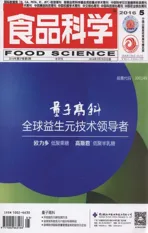葛仙米藻胆蛋白提高小鼠免疫功能的研究
2016-04-15张秋萍汪兴平湖北民族学院生物资源保护与利用湖北省重点实验室湖北恩施445000湖北民族学院生物科学与技术学院湖北恩施445000武汉大学基础医学部免疫系湖北武汉40071
程 超,徐 会,李 伟,张秋萍,汪兴平,*(1.湖北民族学院,生物资源保护与利用湖北省重点实验室,湖北 恩施 445000;.湖北民族学院生物科学与技术学院,湖北 恩施 445000;.武汉大学基础医学部免疫系,湖北 武汉 40071)
葛仙米藻胆蛋白提高小鼠免疫功能的研究
程 超1,2,徐 会3,李 伟2,张秋萍3,汪兴平1,2,*
(1.湖北民族学院,生物资源保护与利用湖北省重点实验室,湖北 恩施 445000;2.湖北民族学院生物科学与技术学院,湖北 恩施 445000;3.武汉大学基础医学部免疫系,湖北 武汉 430071)
摘 要:研究葛仙米藻胆蛋白对昆明小鼠的免疫增强活性。分别以100、300、500 mg/(kg·d)的葛仙米藻胆蛋白溶液剂量对小鼠连续灌胃30 d。然后分别对腹腔巨噬细胞吞噬率、自然杀伤(natural killer,NK)细胞活性,T淋巴细胞增殖、细胞因子、抗体、迟发型超敏反应(delayed type hypersensitivity,DTH)等免疫参数进行测定。结果表明:葛仙米藻胆蛋白可以提高腹腔巨噬细胞吞噬率、NK细胞活性、T淋巴系统增殖以及血清中白细胞介素(interleukin-2,IL-2)和IL-4细胞因子水平。同时葛仙米藻胆蛋白处理组的小鼠DTH显著高于对照组,表明葛仙米藻胆蛋白是一种潜在的免疫增强剂。
关键词:葛仙米;藻胆蛋白;免疫功能;细胞因子
CHENG Chao,XU Hui,LI Wei,et al.Nostoc sphaeroides phycobiliprotein enhances immune functions in mice[J].食品科学,2016,37(5):167-174.DOI:10.7506/spkx1002-6630-201605030.http://www.spkx.net.cn
CHENG Chao,XU Hui,LI Wei,et al.Nostoc sphaeroides phycobiliprotein enhances immune functions in mice[J].Food Science,2016,37(5):167-174.(in English with Chinese abstract)DOI:10.7506/spkx1002-6630-201605030.http://www.spkx.net.cn
The cyanobacterium Nostoc sphaeroides Küting(an edible species of Nostoc)has been used as a food delicacy and ingredient in Chinese medicine since the Eastern Jin Dynasty(317-420 AD),as recorded in The Supplement to Compendium of Materia Medica.It grows in mountain paddy fields in many regions of China during the winter season.The plant forms microscopically visible spherical and sub-spherical colonies and is economically important for local people[1].Some Nostoc sphaeroides Küting are identified as Nostoc sphaeroides,while others are named as N.commune[2].
Algae,like other plants,can produce a variety of useful compounds such as phycobiliprotein,polysaccharides and unsaturated fatty acids.Phycobiliprotein can be divided into phycoerythrin,phycocyanin,phycoerycyanin and allophycocyanin based on their adsorption spectra[3].They are known to have many kinds of biological activities including antioxidant,anticancer and anti-microbial activities[4].Shruti et al.[5]have reported that heat-stable oral alga-based vaccine can protect mice from Staphylococcus aureus infection.Chen Meizhen et al.[6]have demonstrated that the crude phycobiliprotein from Gracilaria lemaneiformis has the capability to improve immune function and antioxidant activity in mice.Although the Nostoc sphaeroides Küting has been widely used in China as food and herb,and its medicinal value has been recorded in Chinese medicinal books two thousand years ago.However,the effect of Nostoc sphaeroides Küting phycobiliprotein(NSKP)on immune functions remains unclear.
In order to explore the effect of NSKP on immune function,the healthy specific pathogen-free(SPF)Kunming mice were orally administered with NSKP at various dosages,and then the immune functions were evaluated.The results showed that NSKP could be a potential immunoenhancing agent.
1 Materials and Methoddss
1.1Materials,animals and reagents
Two hundred and forty SPF female Kunming mice with average body weight of 18-22 g were purchased from the Laboratory Animal Center of Wuhan University(Wuhan,China,SCXK2008-0004).
Nostoc sphaeroides Küting was purchased from Zoumang countryside,Enshi Autonomous prefecture,Hubei Province.
(NH4)2SO4(analytical pure)was purchased from Sinopharm chemical reagent Co.Ltd.; RPMI-1640 medium,Hyclone; trypan blue were purchased from Alfa; cell line K562 was from American Tissue Culture Collection; concanavalin A(ConA)was obtained from Sigma; interleukin-2(IL-2),interleukin-4(IL-4),interleukin-10(IL-10),and interferon-γ(IFN-γ)kits were bought from eBioscience.
1.2Instruments
Genios Microplate ReaderTECAN Co.Ltd.; Highspeed refrigerated centrifuge Beckman; CO2incubator Changsha Hua Xi electronics technetronic Co.Ltd.; 752 UVVis spectrophotometerShanghai Spectrum Instruments Co.Ltd.; SW-CJ-2D double single clean bench Suzhou Purification Equipment Co.Ltd.; MicroscopeOlympus.
1.3Methods
1.3.1Administration methods
The mice were maintained under sterile conditions with a specific pathogen-free environment according to the institutional guidelines for animal care.All experiments were carried out in accordance with the National Institute of Health guidelines for laboratory animal care and use.The mice were administered with NSKP at the dosages of 100,300 and 500 mg/(kg·d)(body mass)by gavage once a day,and phosphate buffered saline(PBS)was used as the control(n = 10).
1.3.2Preparation of NSKP
Nostoc sphaeroides Küting was harvested from Hefeng County in Hubei province.A total of 30 g dry Nostoc sphaeroides Küting powder was dissolved in 50 mmol/L K2HPO4-NaOH(pH 7.3)buffer,and then conducted repeated freezing(-20 ℃)and thawing(room temperature)for 3 times.The solution was centrifuged at 10 000×g and 4 ℃ for 15 min.The supernatant was precipitated with 20%(NH4)2SO4solution and centrifuged at 10 000×g and 4 ℃for 15 min to remove undesirable proteins.The supernatant was precipitated with 60%(NH4)2SO4solution again.Finally,the NSKP was collected after dialysis and the precipitate was dried through lyophilization[7].The purity of obtained phycobiliprotein was 0.65 phycocyanin purity(PC)[8].
1.3.3Phagocytosis assay of peritoneal macrophages
Peritoneal macrophages obtained from experimental mice were suspended in 0.5 mL of RPMI-1640 medium and incubated with 0.5 mL of Candida albicans pre-stained with trypan blue at 37 ℃ for 30 min.The engulfing rate of Candida albicans by macrophages was determined and defined as the phagocytosis rate[9].

1.3.4 Determination of NK cell activity
The splenic NK cells were isolated[10].Briefly,the chronic myelogenous leukemia(CML)cell line K562 was used as the target cells and seeded in 96-well plate at the density of 2 × 104cells per well in RPMI-1640 medium.Splenocytes prepared as described above were used as the effector cells,and added to CML cells at the total amount of 1 × 106cells per well according to the effector cells/target cells(E/T)ratio of 50:1.Three kinds of control measurements were performed:target cells,blank and effector cells.After 20 h incubation in a humidified incubator supplemented with 5% CO2at 37 ℃,the viable cells were measured by 3-(4,5-dimethyl-2-thiazolyl)-2,5-diphenyl-2H-tetrazolium bromide(MTT)assay and the absorption at 540 nm was recorded.The activity of NK cells was calculated as the following equation:

While A540 nmTwas the absorption value of target cell control; A540 nmSwas the absorption value of test samples; A540 nmEwas the absorption value of effector cell control.
The activities of NK cells at the E/T ratios of 25:1,12.5:1 and 6.25:1 were also determined according to the above protocol[11].
1.3.5Proliferation assay of ConA-induced T-lymphocytes
Single-cell suspension was prepared from spleens in RPMI-1640 medium.Briefly,the cell suspension was achieved by puncturing the spleen with a 20-gauge needle and gently flushing the organ with ice-cold(4 ℃)culture medium.The suspension was free from debris by centrifugation at 1 000×g and 4 ℃ for 20 min.The remaining splenocyte suspension was washed twice and adjusted to the density of 2 × 106cells per mL using RPMI-1640 medium.A total of 200 μL of splenocyte suspension was cultured in a 96-well plate in the presence or absence of T-cell mitogen(ConA,5 μg/mL).Meanwhile,the RPMI-1640 medium without ConA was used as the control.All cells were cultured in a humidified incubator supplemented with 5% CO2at 37 ℃ for 48 h,the viable cells were measured by MTT assay as above-mentioned method,proliferation numberwas shown as(A570 nm mitogen-A570 nm control)in this study[12].
1.3.6Assessment of cytokines
Using the lymphocyte culture supernatant prepared by the method of 1.3.5 as materials,the levels of IL-2,IL-4,IL-10,and IFN-γ in the presence or absence of ConA were determined by enzyme-linked immunosorbent assay(ELISA)kits according to the manufacturer’s instructions[13].
The IL-2,IL-4,IL-10,and IFN-γ level were calculated by the IL-2,IL-4,IL-10,and IFN-γ level in the presence of ConA menus IL-2,IL-4,IL-10,and IFN-γ level in the absence of ConA.
1.3.7Direct haemagglutination assays
After the administration with NSKP for 26 consecutive days,the mice were sensitized with 5% sheep red blood cells(SRBCs,200 μL/mouse)[14].Four days later,direct haemagglutination assay was completed in 96 V-bottomed well plates.Totally 50 μL of mouse serum samples at the dilution ratio of 1:25 were placed in the first well and serial double dilutions were prepared by using PBS.The well containing PBS alone was served as the negative control.In addition,25 μL of 2% SRBC was then added to each well and incubated at 37 ℃ for 1 h.Haemagglutination was monitored by inclining the plates at a 45° angle and a positive result was recorded at the condition with the agglutination of approximately 50% SRBC.All experiments for each animal were conducted in duplicate at the same time.
1.3.8Serum hemolysis(hemolytic complement activity,HC50)
The sera from guinea pigs and SRBC-immunized mice were diluted by 9 fold and 500 fold using 0.9% NaCl solution,respectively.Then,1 mL of mouse serum and 1 mL of guinea pig serum were mixed with 0.5 mL SRBC(10%(V/V)in 0.9% NaCl).Meanwhile,0.9% NaCl without mouse serum was used as the control.After incubating at 37 ℃ for 30 min,the mixture was centrifuged at 2 000×g and 4 ℃ for 10 min to remove intact erythrocytes.Supernatant was collected and mixed with 3 mL stop solution(31.0 g/L NaHCO3,0.5 g/L KCN,0.2 g/L K3Fe(CN)6).The hemoglobin contents in supernatant were determined by a photometer at 540 nm to represent the serum hemolytic complement activity[15].

1.3.9The response of delayed-type hypersensitivity(DTH)
After treatment with NSKP for 25 consecutive days,the abdominal skin of mice was shaved and the exposed skin was smeared with 50 μL of 10 g/L dinitrofluorobenzene(DNFB)in acetone-gingili oil(1:1 in volume).Five days later,10 μL of DNFB solution was smeared on both sides of the right ear.After 24 h,the ear was punched with an ear punch(8 mm in diameter)and the DTH response was evaluated by measuring thickness difference between right and left ears[16].
Swelling degree/mm= Right ear thickness/mm-Left ear thickness/mm (4)
1.3.10 Determination of spleen index and thymus index
After treatment with NSKP for 30 consecutive days,determine the spleen’s and thymus’s mass respectively[16],the spleen index and thymus index were determined.

1.4Statistical analysis
Data were analyzed by one-way analysis of variance(ANOVA),followed by Dunnett’s t-test.The results were expressed as.A statistically significant difference was considered at P < 0.05[17].
2 Results and Analysiiss
2.1Effect of Nostoc sphaeroides Küting phycobiliprotein on phagocytic capacity of macrophages
The innate immune system has extraordinary strong resistance to microbial infections[18].In order to evaluate whether NSKP can improve the innate immune function,we explored the effect of NSKP on macrophage phagocytosis of Candida albicans as the description in 1.3.3.
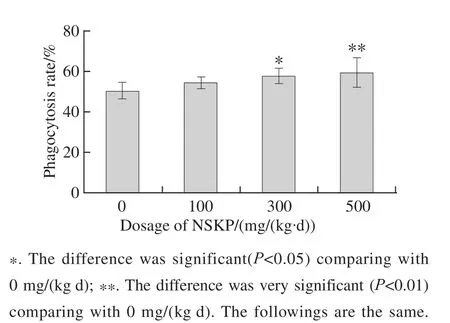
Fig.1 Effect of NSKP on phagocytic capacity of macrophages
As shown in Fig.1,the phagocytic rate revealed a significant increase in both high dosage((59.22 ± 11.62)%)and medium dosage((57.60 ± 6.82)%)groups during NSKP treatments whe n compared with the control group((50.50 ± 3.03)%).These results indicated that NSKP could potentially enhance the phagocytosis of macrophages.
2.2Effect of NSKP on the cytotoxic activity of NK cells against K562 cells
As well known,NK cells play distinctive roles in innate immunity against infections and tumor development[19].Therefore,we investigated the effect of NSKP on the cytotoxicity of splenic NK cells againstK562 cells.

Fig.2 Effect of NSKP on NK cell killing activity of K562 cells
The activity of NK cells in experimental mouse spleen revealed a significant enhancement(P < 0.05)due to the administration of NSKP at different dosages under the condition with NK-K562 ratio of 50:1(Fig.2A).However,under the condition with NK-K562 ratio of 25:1(Fig.2B)and NK-K562 ratio of 6.25:1(Fig.2B),only the administration of NSKP at the medium dosage revealed a significant difference when compared with the control group.Moreover,at the NK-K562 ratio of 12.5:1,a dramatic increase in killing rate in low-dosage and high-dosage NSKP groups was observed when compared with the control group(Fig.2C).All of these results indicated that NSKP has an obvious immunomodulatory effect on NK cells in vivo.
2.3Effect of NSKP on the proliferation of ConA-induced T-lymphocytes
T cells can secrete cytokines to immune functions in thebody.Upon the stimulation of antigen,T cells can proliferate and differentiate into effector T cells,thereby resulting in the direct lysis of target cells.
ConA is a mitogen and can selectively stimulate the proliferation and activation of T cells in lymphocytes.Herein,the effect of NSKP on the proliferation of T-lymphocytes in spleen in the presence of ConA was explored by MTT assay.

Fig.3 Effect of NSKP on ConA-induced T-lymphocyte proliferation
A significant increasing in T-lymphocyte proliferation was observed after the administration of NSKP at the medium dosage(A570 nm mitogen-A570 nm control=0.138 91±0.062 87)and the high dosage(A570 nm mitogen-A570 nm control=0.141 10±0.058 52).However,compared with the control group(A570 nm mitogen-A570 nm control= 0.078 83±0.028 24),the administration of NSKP at the low dosage(A570 nm mitogen-A570 nm control=0.070 63±0.036 85)had no obvious difference when compared with the control group.These results indicated that NSKP could improve the proliferation of T cells induced by ConA.
2.4Effect of NSKP on the secretion of IL-2,IL-4,IL-10 and IFN-γ in T cells
Cytokines play critical roles in regulating antigen-specific antibody responses in T cells and B cells.When the T cells are exposed to an antigen,the cytokine profile represents T-helper cell subsets.T-helper cell 1(Th1)responses are identified primarily by the secretion of IL-2 and IFN-γ,while Th2 responses are identified by the secretion of IL-4 and IL-10[20].In order to identify the potential modulation function of NSKP to Th1 and Th2 immune responses,ELISA was conducted to determine the secretion level of cytokines by T cells in the peripheral blood due to the administration of NSKP.
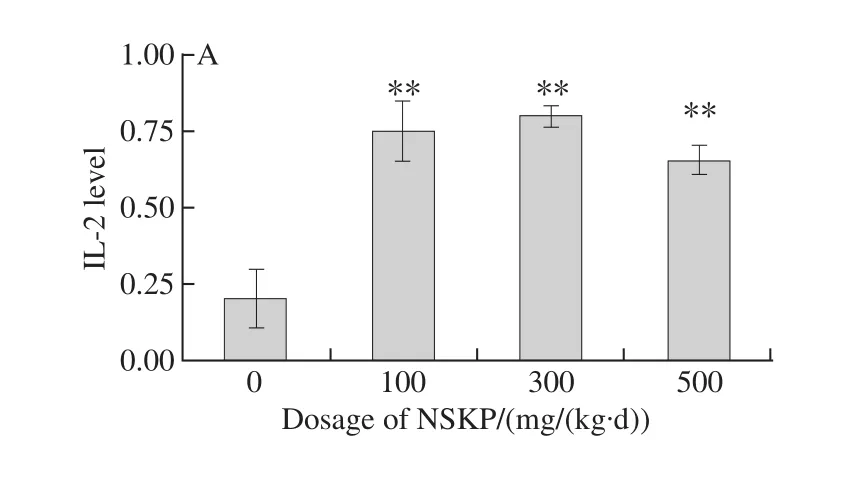
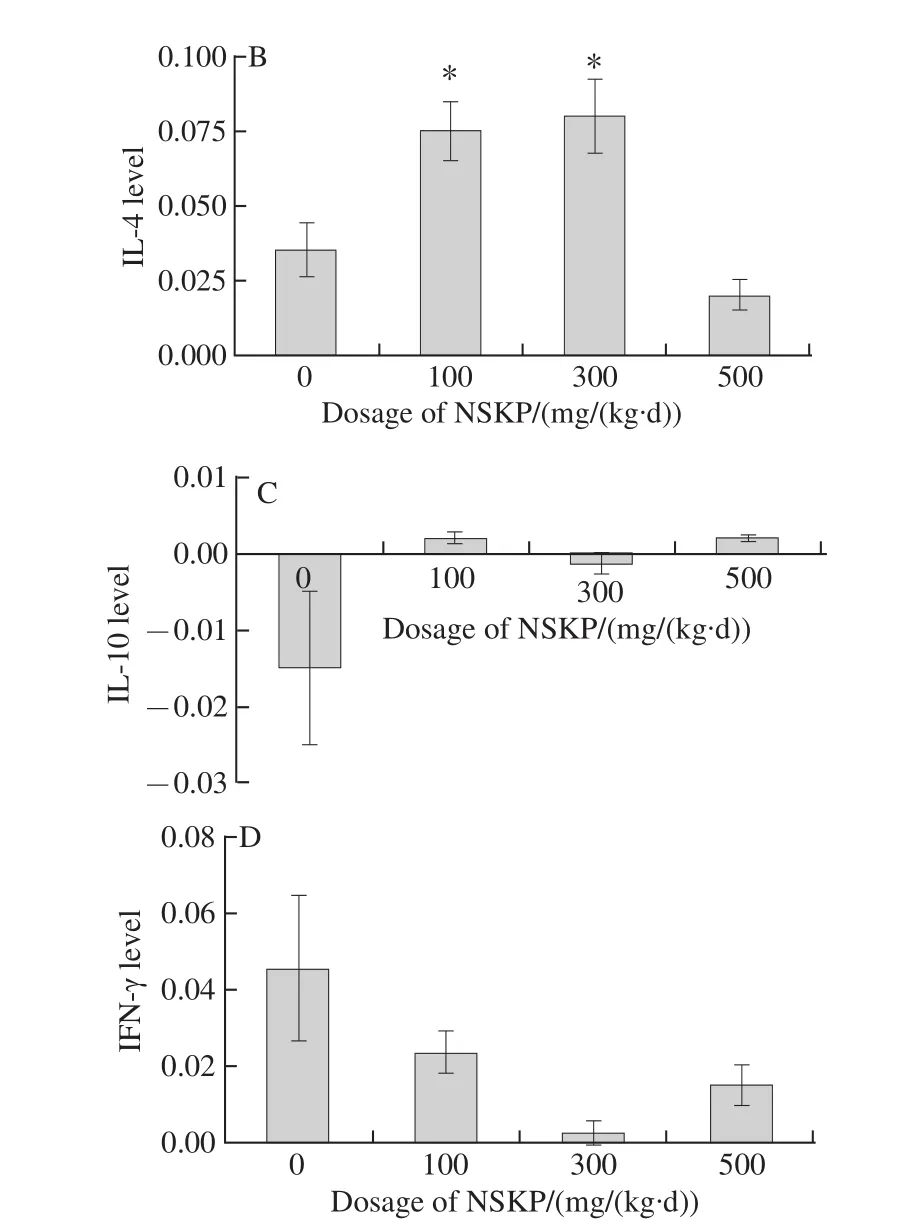
Fig.4 Effect of NSKP on T cells’ ability to secrete IL-2,IL-4,IL-10 and IFN-γ
A significant elevation of IL-2 was observed in the NSKP treatment groups at three dosage levels when compared with the control group(Fig.4A).In contrast,the administration of NSKP alone at the medium dosage resulted in a significant increase of IL-4(Fig.4B).No obvious change in IL-10(Fig.4C)and IFN-γ(Fig.4D)was observed between the experiment groups and the control group.Thus,NSKP may promote the production of IL-2 and IL-4,and influence both Th1 and Th2 subsets.
2.5Effect of NSKP on antibody production and hemolytic complement activity
“有戏!”进博会上,意大利美妆品牌Robeus和Bellaoggi展台工作人员接受媒体采访时脱口而出。事实上,在此次进博会之前,他们在中国并没有正式的销售渠道,甚至没有个人“代购”。然而,进博会让他们看到了中国消费者对新品牌的热情。
Humoral immunity,as an important part of the specific immunity,plays an immune role together with cellular immunity.Whether phycobiliprotein can improve the function of B lymphocytes is still elusive.According to the previous report,immunization with SRBCs can result in the appearance of specific anti-SRBC antibody in serum,which can lead to the cytolytic response against SRBC[21].In the present study,the cytolytic response against SRBC revealed an obvious increase in NSKP groups when compared with the control group.The generation of the antibody in the high-dose NSKP group was significantly higher than that in other groups(Fig.5A).In addition,the level of serum hemolysis was determined by optical density at 540 nm.As shown in Fig.5B,NSKP dramatically enhanced the HC50in all 3 dosages when compared to thecontrol group.These results indicated that NSKP could enhance the humoral immune function.

Fig.5 Effect of NSKP on the ability of producing antibody and hemolytic complement activity
2.6Effect of NSKP on the cytotoxic function of T cellskilling function
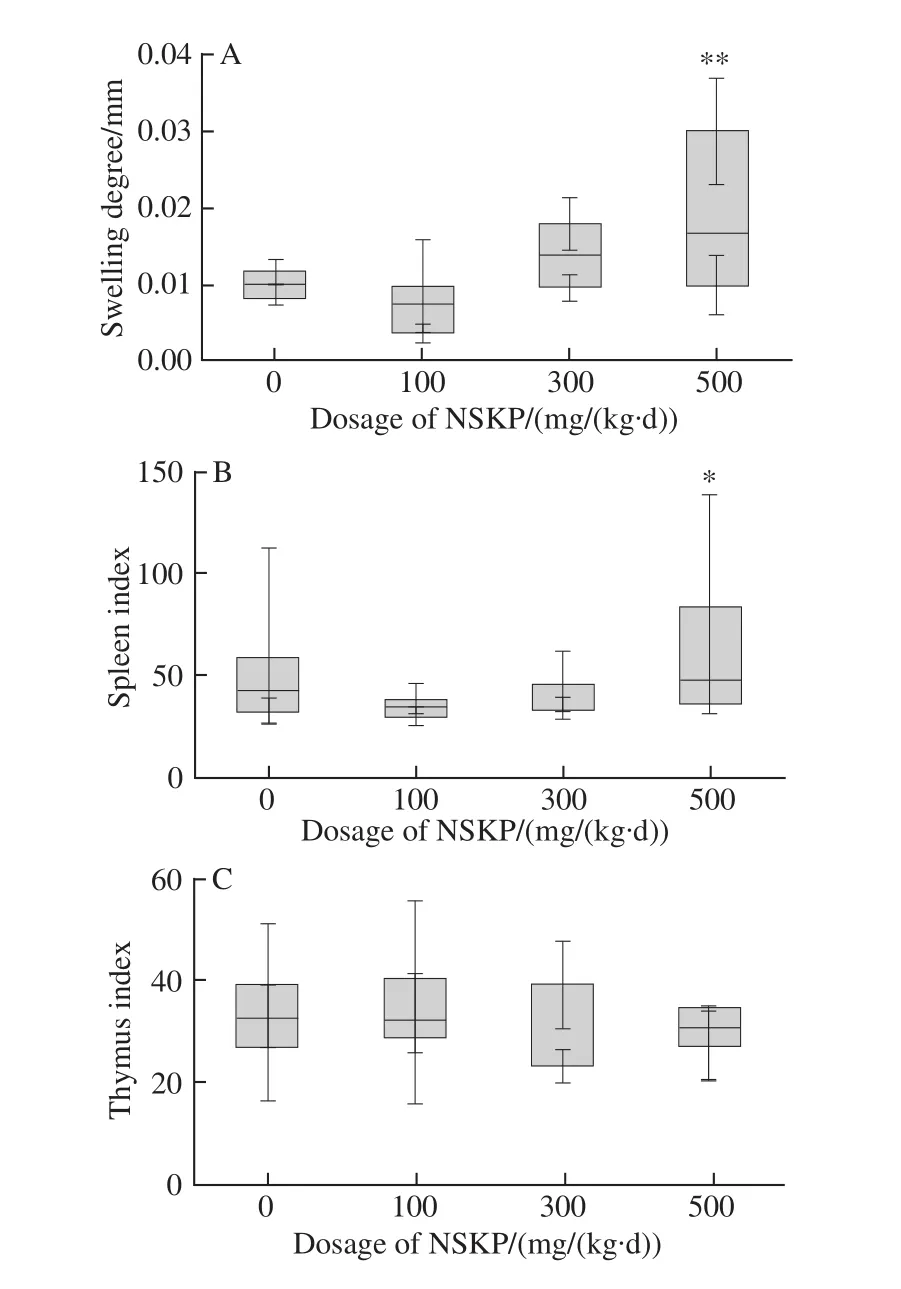
Fig.6 Effect of NSKP on T-cell killing function
Delayed type hypersensitivity(DTH)reaction is a cellmediated pathological response involving in the activation of T cells and the production of various cytokines[22].The effect of NSKP on antigen-specific cellular immunity in experimental animals was measured by the degree of DTH response using the ear-swelling test.
The results indicated that a significant increase in ear-swelling rate(Fig.6A)and spleen index(Fig.6B)was observed in high-dose NSKP group when compared with the control group.However,NSKP had no significant effect on thymus index when compared with the control group(Fig.6C).These results indicated that NSKP could strengthen the cellular immunity in experimental animals.
3 Discusssiioonn
Cyanobacteria are an ancient,large and diverse group of oxygenic photoautotrophic prokaryotic organisms[23].Nostoc sphaeroides is a valuable medicinal and edible cyanobacterium with total protein content as high as 48.61%.It is known to be effective in eliminating fatigue and curing night blindness.Phycobiliproteins have a variety of applications such as anticancer and antioxidation[24].Phycocyanin from S.platensis at high concentration can inhibit the growth of human leukaemia cells[25-26].Phycocyanin and phycoerythrin have an obviously inhibitory effect on the proliferation of HeLa cells[27-30].Meanwhile,the phycocyanin from S.platensis reveals strong inhibitory effect on the activity of T and B lymphocytes as well as the production of the specific antibody[31].However,the potential immune functions of NSKP are still unclear.In our study,the enhanced innate and adaptive immunity of NSKP in healthy SPF mice has been confirmed.
The innate immunity includes phagocytosis of peritoneal macrophages and NK cell activity.The effect of NSKP on the phagocytosis of peritoneal macrophages was studied in vivo.The results showed that NSKP at high dosage enhanced the macrophage phagocytosis of Candida albicans in mice.Because macrophages are pivotal cells in acute inflammation,they have the responsibility of non-specific host defense and play an important role in antigen-presenting process,which leads to the production of antigen-specific antibody.The increased phagocytic capacity will improve the immune function of macrophages[32].
NK cells are a type of lymphocytes and the first line of innate defense against cancer cells and virus-infected cells.The cytotoxicity of NK cells is non-specific,and NK cells are not necessary for target cells to recognizeantigen MHC(major histocompatibility complex).NK cell level is closely related to immune function status[33].In this study,NSKP significantly enhanced the cytotoxicity of NK cells against K562 cells.Therefore,NSKP is a potential immunoenhancing agent.
The adaptive immunity,including both humoral and cellular immunity,is more specific than innate immunity.In this study,we have demonstrated the elevation of IL-4 resulted from NSKP administration and the corresponding enhancement of humoral immune function.Meanwhile,the effect of NSKP on B cell functions was further examined by determining the specific humoral immune response to SRBC.A significant increase in generation of antibody-producing plasma cells from B cell differentiation was observed.Similarly,the increased serum hemolysis was also detected.These results were consistent with the enhanced effect of NSKP on both the phagocytic capacity of macrophages and the proliferation of T cells in the response to antibody[34].
Type IV hypersensitivity response is a pathological form of cellular immunity.In our study,the response of DNFB-induced type IV hypersensitivity was used to explore the impact of NSKP on cellular immune function.A significant increase in ear-swelling rate was observed in high-dose NSKP group.Therefore,NSKP can promote T cell-mediated hypersensitivity.
In conclusion,NSKP can remarkably increase the phagocytosis of peritoneal macrophages,the activity of NK cells,the proliferation of ConA-induced T-lymphocytes and the level of IL-4.NSKP also can enhance B cell response to antigen and promote DTH reaction,thus promoting both innate and adaptive immune functions.Taken together,NSKP can be used as a clinical potential immunoenhancing agent.
Referenncceess::
[1]CHEN M Z,GE A S,YU J,et al.Studies on the antitumor activities of phycoerythrin from Gracilaria lemaneiformis[J].Chinese Journal of Marine Drugs,2007,26(4):27-31.
[2]HUANG Z B,LIU Y D,PAULSEN B S.Studies on polysaccharides from three edible species of Nostoc(Cyanobacteria)with different colony morpholoRPMIes,comparison of monosaccharide compositions and viscosities of polysaccharides from field colonies and suspension cultures[J].Journal of Phycology,1998,34(6):962-968.DOI:10.1046/j.1529-8817.1998.340962.x.
[3]SUN L,WANG S.Allophycocyanin complexes from the phycobilisome of a thermophilic blue-green alga Myxosarcina concinna Printz[J].Journal of Photochemistry and Photobiology B(Biology),2003,72(1/2/3):45-53.DOI:10.1016/j.jphotobiol.2003.07.006.
[4]SHALABY E.Algae as promising organisms for environment and health[J].Plant Signaling and Behavior,2011,6(9):1338-1350.DOI:10.4161/psb.6.9.16779.
[5]SHRUTI S,ARCHAHA M,JINU J.Immunomodulatory activities of the ethanolic extract of Caesalpinia bonducella seeds[J].Journal of Ethnopharmacology,2009,125(2):252-256.DOI:10.1016/j.jep.2009.07.002.
[6]CHEN M Z,YU J,ZHONG Q L,et al.Study on the immunity function and anti-oxidation activity of phycobiliproteins from Gracilaria lemaneiformis[J].Food Science,2005,26(9):456-459.
[7]SONI B,TRIVEDI U,MADAMWAR D.A novel method of single step hydrophobic interaction chromatography for the purification of phycocyanin from Phormidium fragile and its characterization for antioxidant property[J].Bioresource Technology,2008,99(1):188-194.DOI:10.1016/j.biortech.2006.11.010.
[8]PATIL G,RAGHAVARAO K S M S.Aqueous two phase extraction for purification of C-phycocyanin[J].Biochemical Engineering Journal,2007,34(2):156-164.DOI:10.1016/j.bej.2006.11.026.
[9]JUE T,SUNA H X,YEB Y P.Immunomodulatory and antitumor activity of triterpenoid fractions from the rhizomes of Astilbe chinensis[J].Journal of Ethnopharmacology,2008,119(2):266-271.DOI:10.1016/j.jep.2008.07.007.
[10]CHEN B A,JIN N,WANG J,et al.The effect of magnetic nanoparticles of Fe3O4on immune function in normal ICR mice[J].International Journal of Nanomedicine,2010,5:593-599.DOI:10.2147/IJN.S12162.
[11]KREISS A,WELLS B,WOODS G M.The humoral immune response of the Tasmanian devil(Sarcophilus harrisii)against horse red blood cells[J].Veterinary Immunology and Immunopathology,2009,130(1/2):135-137.DOI:10.1016/j.vetimm.2009.02.003.
[12]MATHIEU G,TRUDELLE É B,DUGAS V.Macrophage-mediated responses to Candida albicans in mice expressing the human immunodeficiency virus type 1 transgene[J].Infection and Immunity,2009,77(9):4136-4149.DOI:10.1128/IAI.00453-09.
[13]KRZYŻOWSKA M,WINCENCIAK M,WINNICKA A.The effect of multigenerational diet containing genetically modified triticale on immune system in mice[J].Polish Journal of Veterinary Sciences,2010,13(3):423-430.
[14]LEE J Y,KIM C J.Arctigenin,a phenylpropanoid dibenzylbutyrolactone lignan,inhibits type I-IV allergic inflammation and pro-inflammatory enzymes[J].Archives of Pharmacal Research,2010,33(6):947-957.DOI:10.1007/s12272-010-0619-1.
[15]SUN Y,LI H,ALAN N L.Altered allogeneic immune responses in medium-aged mice[J].Cellular and Molecular Immunology,2004,1(6):440-446.
[16]MAHABOOBKHAN R,EVAN P S.Appraisal of immunomodulatory potential of Spirulina fusiformis,an in vivo and in vitro study[J].Journal of Natural Medicines,2009,63(2):169-175.DOI:10.1007/s11418-008-0308-2.
[17]RASOOL M,VARALAKSHMI P.Immunomodulatory role of Withania somnifera root powder on experimental induced inflammation,an in vivo and in vitro study[J].Vascular Pharmacology,2006,44(6):406-410.DOI:10.1016/j.vph.2006.01.015.
[18]LEFKOWITZ D L,STUART R,GNADE B T.Effects of a glyconutrient on macrophage functions[J].International Journal of Immunopharmacology,2000,22(4):299-308.DOI:10.1016/S0192-0561(99)00085-5.
[19]HAN Q,LING Z,HE P M.Immunomodulatory and antitumor activity of polysaccharide isolated from tea plant flower[J].Progress in Biochemistry and Biophysics,2010,37(6):646-653.DOI:10.3724/SP.J.1206.2009.00656.
[20]YANG H,LIU S,IBRAHIM S A.Oral administration of live Bifidobacterium substrains isolated from healthy centenarians enhanced immune function in BALB/c mice[J].Nutrition Research,2009,29(4):281-289.DOI:10.1016/j.nutres.2009.03.010.
[21]KOENEN M E,KRAMER J,van der HULST R.Immunomodulation by probiotic lactobacilli in layerand meat-type chickens[J].British Poultry Science,2004,45(3):355-366.
[22]SEIDLER D G,MOHAMED N A,BOCIAN C.The role for decorin in delayed-type hypersensitivity[J].The Journal of Immunology,2011,187(11):6108-6119.DOI:10.4049/jimmunol.1100373.
[23]WANG X,XIE B,PAN S,et al.Optimization of technology for extracting phycobiliproteins from Nostoc sphaeroides Kütz[J].Transactions of the Chinese Society of Agricultural Engineering,2006,22(4):227-229.
[24]PERTTI J V,CHRISTA L C.Rapid extraction of phycobiliproteins from cultured cyanobacteria samples[J].Analytical Biochemistry,2003,319(2):263-271.DOI:10.1016/S0003-2697(03)00294-X.
[25]ZHANG C W,LIU Y F,WANG X X,et al.The effect of phycobiliprotein from Spirulina platenis on the growth of human leukaemia cell[J].Bulletin of Marine Science,2000,24(10):45-48.
[26]SUBHASHINI J,MAHIPAL S V K,REDDY M C.Molecular mechanisms in C-phycocyanin induced apoptosis in human chronic myeloid leukemia cell line-K562[J].Biochemical Pharmacology,2004,68(3):453-462.DOI:10.1016/j.bcp.2004.02.025.
[27]WANG Y,QIAN F,QIAN K X,et al.Anticancer activity of phycocyanin[J].Journal of Zhejiang University(Engineering Science),2001,35(6):672-675.
[28]CHEN Z,JUNEAU P,QIU B.Effects of three pesticides on the growth,photosynthesis and photoinhibition of the edible cyanobacterium Ge-Xian-Mi(Nostoc)[J].Aquatic Toxicology,2007,81(3):256-265.DOI:10.1016/j.aquatox.2006.12.008.
[29]LI X L,XU G,CHEN T F.Phycocyanin protects INS-1E pancreatic beta cells against human islet amyloid polypeptide-induced apoptosis through attenuating oxidative stress and modulating JNK and p38 mitogen-activated protein kinase pathways[J].The International Journal of Biochemistry and Cell Biology,2009,41(7):1526-1535.DOI:10.1016/j.biocel.2009.01.002.
[30]WANG X Q,FAN M,YANG C Y,et al.Study on biological functions of Spirulina platensis phycocyanin and its hydrolysates by trypsinase[J].Journal of Food Science,2008,29(10):433-435.
[31]LI B.Research on the extraction,purification and antitumor immune activity of C-phycocyanin from Spirulina platensis(Arthrospira platensis)[D].Qingdao:Ocean University of China,2006.
[32]MORETTA L,BOTTINO C,CANTONI C.Human natural killer cell function and receptors[J].Current Opinion in Pharmacology,2001,1(4):387-391.DOI:10.1016/S1471-4892(01)00067-4.
[33]ZHANG J,SUN R,WEI H M.Antitumor effects of recombinanthuman prolactin in human adenocarcinoma-bearing SCID mice with human NK cell xenograft[J].International Immunopharmacology,2005,5(2):417-425.DOI:10.1016/j.intimp.2004.10.008.
[34]TU J,SUN H X,YE Y P.Immunomodulatory and antitumor activity of triterpenoid fractions from the rhizomes of Astilbe chinensis[J].Journal of Ethnopharmacology,2008,119(2):266-271.DOI:10.1016/j.jep.2008.07.007.
中图分类号:TS201.21
文献标志码:A
文章编号:1002-6630(2016)05-0167-08
DOI:10.7506/spkx 1002-6630-201605030
作者简介:程超(1976—),女,教授,博士,研究方向为天然产物化学。E-mail:chengchaolw@126.com*通信作者:汪兴平(1963—),男,教授,博士,研究方向为天然产物化学。E-mail:hbmywxp@163.com
基金项目:国家自然科学基金地区科学基金项目(31260365;31560434)
收稿日期:2015-09-24
引文格式:
